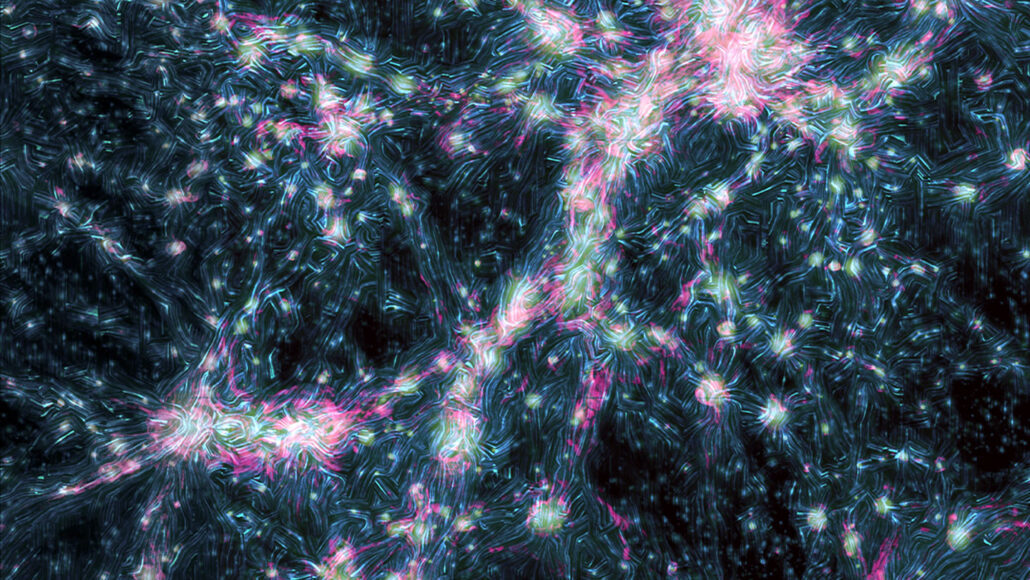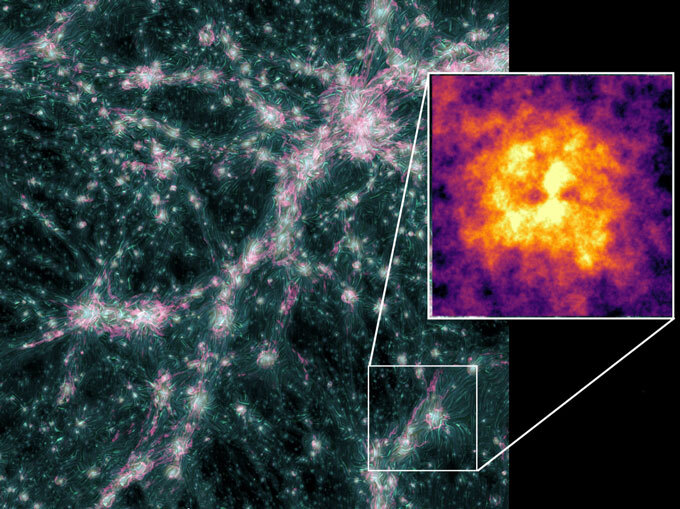7.03.2023
The observation could offer an indirect look at large-scale magnetic fields in the universe

In this simulation of the cosmic web, shock waves along filaments and around clusters emit radio light (pink) as they ripple through magnetic fields (cyan).
F. VAZZA, D. WITTOR AND J. WEST
For the first time, astronomers have caught a glimpse of shock waves rippling along strands of the cosmic web — the enormous tangle of galaxies, gas and dark matter that fills the observable universe.
Combining hundreds of thousands of radio telescope images revealed the faint glow cast as shock waves send charged particles flying through the magnetic fields that run along the cosmic web. Spotting these shock waves could give astronomers a better look at these large-scale magnetic fields, whose properties and origins are largely mysterious, researchers report in the Feb. 17 Science Advances.
Finally, astronomers “can confirm what so far has only been predicted by simulations — that these shock waves exist,” says astrophysicist Marcus Brüggen of the University of Hamburg in Germany, who was not involved in the new study.
At its grandest scale, our universe looks something like Swiss cheese. Galaxies aren’t distributed evenly through space but rather are clumped together in enormous clusters connected by ropy filaments of dilute gas, galaxies and dark matter and separated by not-quite-empty voids (SN: 10/3/19).
Tugged by gravity, galaxy clusters merge, filaments collide, and gas from the voids falls onto filaments and clusters. In simulations of the cosmic web, all that action consistently sets off enormous shock waves in and along filaments.
Filaments make up most of the cosmic web but are much harder to spot than galaxies (SN: 1/20/14). While scientists have observed shock waves around galaxy clusters before, shocks in filaments “have never been really seen,” says astronomer Reinout van Weeren of Leiden University in the Netherlands, who was not involved in the study. “But they should be basically all around the cosmic web.”
Shock waves around filaments would accelerate charged particles through the magnetic fields that suffuse the cosmic web (SN: 6/6/19). When that happens, the particles emit light at wavelengths that radio telescopes can detect — though the signals are very weak.

Simulations of the cosmic web and its magnetic field (cyan), like the one pictured here, predict that shockwaves along filaments and around galaxy clusters should emit weak radio signals (pink). The inset shows what combining many radio images of galaxy cluster pairs in the simulated web might look like, with colors representing gas temperature and density (high values are yellow, low values are purple and black).F. VAZZA, D. WITTOR AND J. WEST
A single shock wave in a filament “would look like nothing, it’d look like noise,” says radio astronomer Tessa Vernstrom of the International Centre for Radio Astronomy Research in Crawley, Australia.
Instead of looking for individual shock waves, Vernstrom and her colleagues combined radio images of more than 600,000 pairs of galaxy clusters close enough to be connected by filaments to create a single “stacked” image. This amplified weak signals and revealed that, on average, there is a faint radio glow from the filaments between clusters.
“When you can dig below the noise and still actually get a result — to me, that’s personally exciting,” Vernstrom says.
The faint signal is highly polarized, meaning that the radio waves are mostly aligned with one another. Highly polarized light is unusual in the cosmos, but it is expected from radio light cast by shock waves, van Weeren says. “So that’s really, I think, very good evidence for the fact that the shocks are likely indeed present.”
The discovery goes beyond confirming the predictions of cosmic web simulations. The polarized radio emissions also offer a rare peek at the magnetic fields that permeate the cosmic web, if only indirectly.
“These shocks,” Brüggen says, “are really able to show that there are large-scale magnetic fields that form [something] like a sheath around these filaments.”
He, van Weeren and Vernstrom all note that it’s still an open question how cosmic magnetic fields arose in the first place. The role these fields play in shaping the cosmic web is equally mysterious.
“It’s one of the four fundamental forces of nature, right? Magnetism,” Vernstrom says. “But at least on these large scales, we don’t really know how important it is.”
Quelle: ScienceNews
